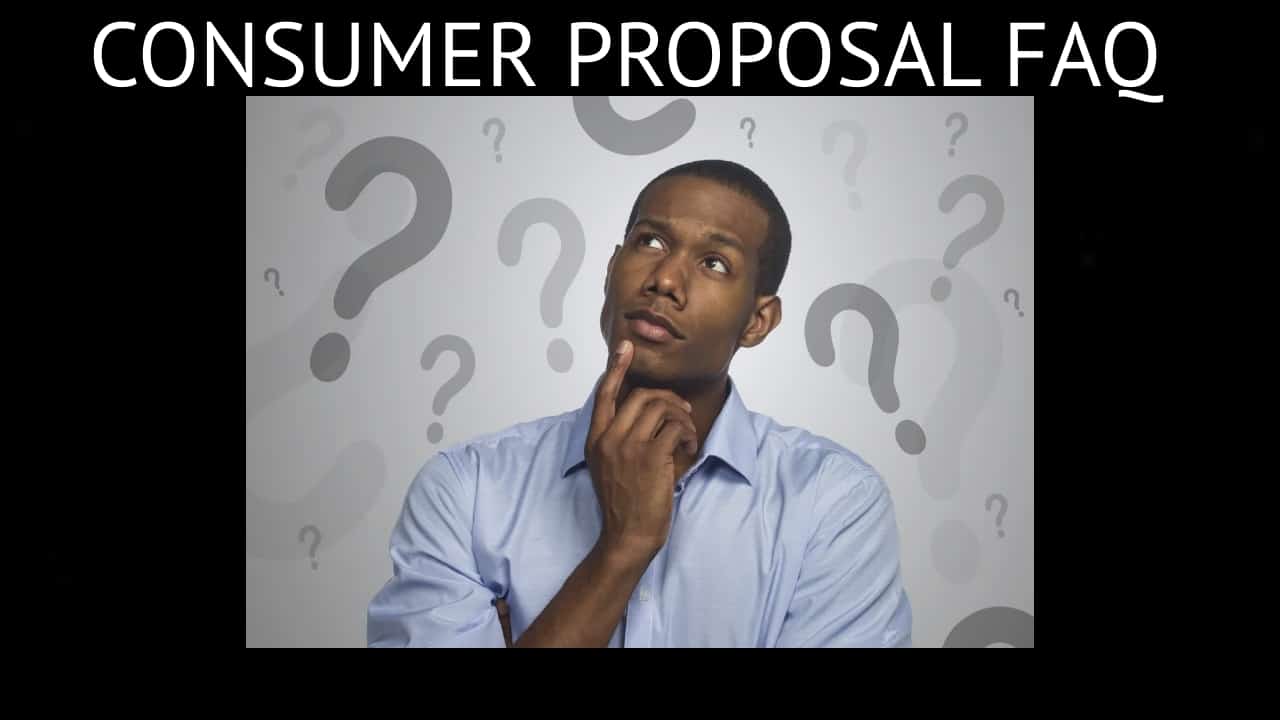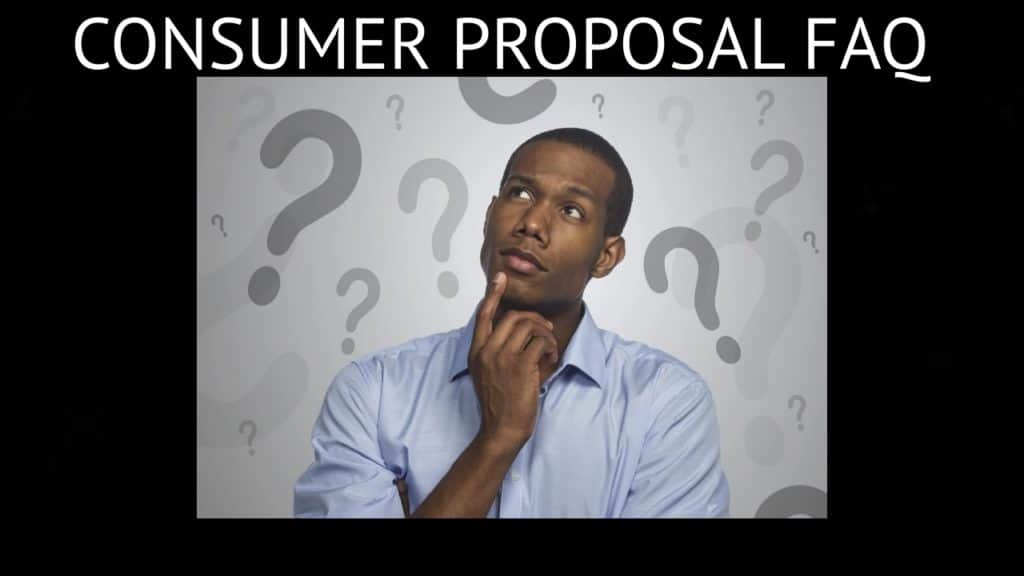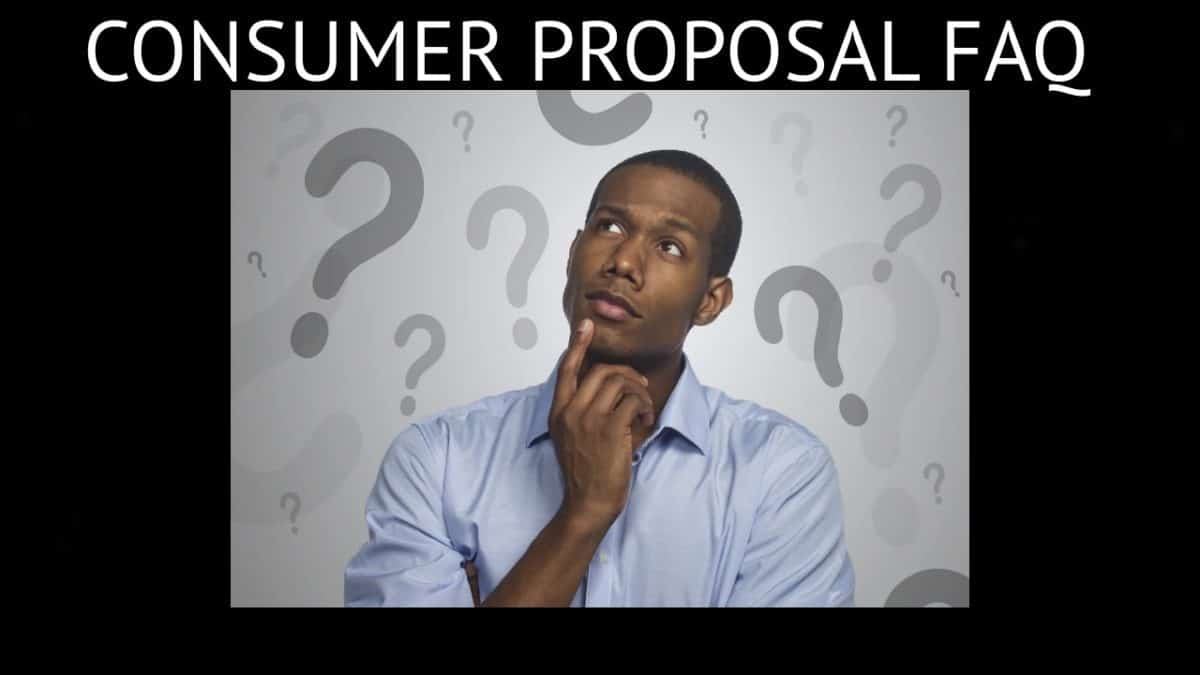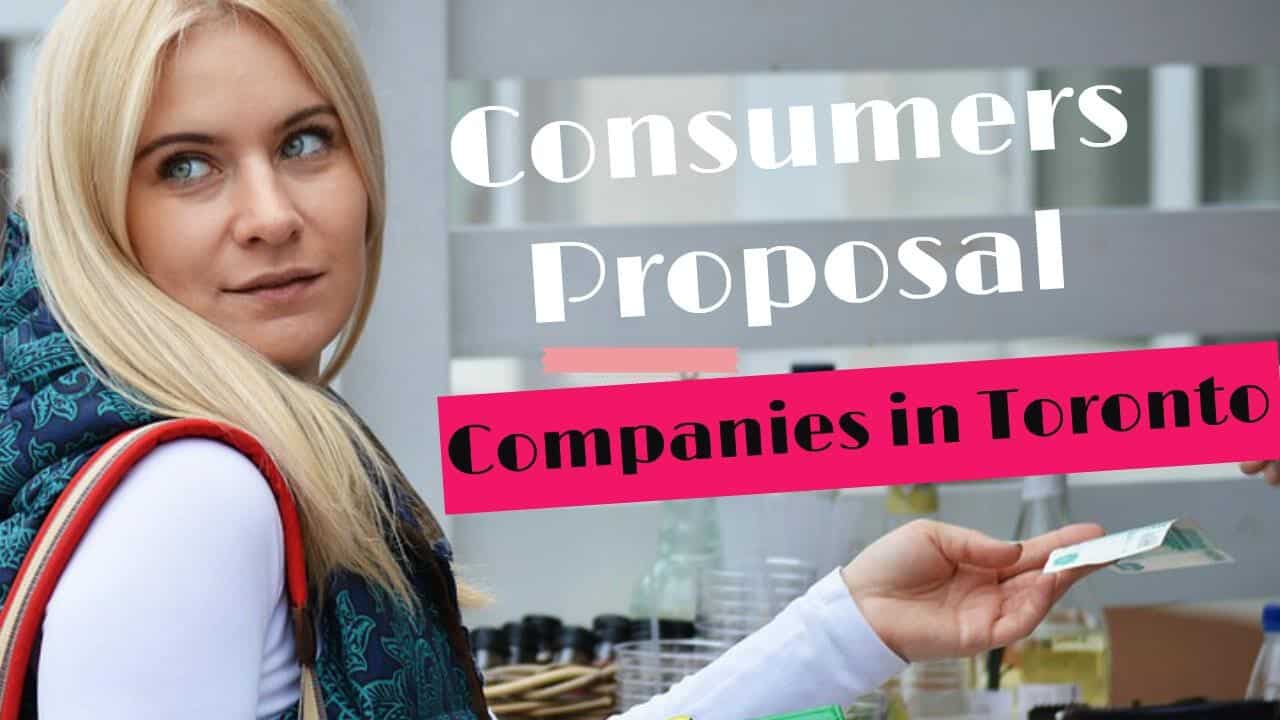We hope that you and your family are safe, healthy and secure during this coronavirus pandemic.
Ira Smith Trustee & Receiver Inc. is absolutely operational and Ira, in addition to Brandon Smith, is readily available for a telephone consultation or video meeting.

Consumer proposal faq introduction
If you’re struggling with financial obligations, you’ve probably thought about declaring bankruptcy. You may have listened to advertisements or people saying that a consumer proposal or bankruptcy is basically the exact same, however, there are some essential distinctions. That confusion has actually led me to create this consumer proposal faq.
Under a consumer proposal, you bargain a repayment strategy with your creditors (individuals you owe money to), yet you don’t lose your assets. Depending on exactly how rapidly you can pay it off, you can be discharged a whole lot quicker from a consumer proposal than from a bankruptcy. While bankruptcy will certainly remain on your credit record for 7 years after discharge, a consumer proposal can be gotten rid of in about half that time.
In this Brandon Blog, I answer the most usual questions concerning consumer proposals which is why I call this blog the consumer proposal faq blog.
Consumer proposal faq: What are the common benefits of filing a consumer proposal?
Filing a consumer proposal in Canada is a great way to help manage your overloaded financial situation. A consumer proposal is a legal alternative to bankruptcy that helps you work out a payment plan for your creditors. It allows you to pay back a portion of your debt, eliminate the rest of your debts while keeping the remainder of your possessions and giving you a fresh start.

Consumer proposal faq: What does a consumer proposal cost?
A consumer proposal is an official arrangement to pay off your financial debts over a specific time period. While there are different kinds of consumer proposals, the basic idea remains the same. Consult with a licensed insolvency trustee (previously called a bankruptcy trustee) (Trustee) who will certainly analyze your scenario and figure out whether a consumer proposal is a good fit for your situation.
The Trustee will also prepare a consumer proposal that takes into account the settlement plan for the creditors that you can afford to make the monthly payments on. The estimation of the minimum amount to offer your creditors is determined by the Canadian bankruptcy law laid out in the Bankruptcy and Insolvency Act (Canada) (BIA). The BIA states that your creditors must be offered something better than they would get in your bankruptcy.
To do that computation, the Trustee will identify if, in a bankruptcy, you would have to make any kind of surplus income payments. The Trustee would additionally find out the value of any of your assets that would be non-exempt and would have to be turned over in bankruptcy to the Trustee.
Once the Trustee has actually made those determinations, the Trustee can then tell you the minimum dollar value you need to offer your creditors. When you and the Trustee agree on the regular monthly payments and the length of time you require to make them (no greater than 60 months), the Trustee can prepare your consumer proposal and related filing documents.
The Trustee’s fee is regulated by the BIA. That guideline of the statute entitles the Trustee to what is called the tariff. That tariff is paid from the amount you pay to the Trustee as Proposal Administrator. The Trustee is able to deduct the tariff fee from the total payments you made. Because the amount you pay is calculated without any connection to the Trustee fee, that implies the services of the Trustee are free!
Consumer proposal faq: What debts can be included in a consumer proposal?
If you need to submit a consumer proposal, you can include the majority of your debt, however, there are exceptions. For example, secured debt, such as mortgages and auto loans, cannot be included. Financial debts that are the outcome of fraud and unpaid court fines or traffic fines, can additionally be excluded. The reason for this is since such debts are not discharged by a discharge from bankruptcy.
So it is most likely that the creditors that are owed cash from such types of financial debt would possibly vote against your consumer proposal. My assumption is that a judgement against someone for fraud will be huge enough that their vote will swamp the various other votes. However, that does not suggest you should not try.
Overdue income tax owing to Canada Revenue Agency (CRA) is a debt that can likewise be included in your consumer proposal. For that reason, tax debt forgiveness can be completed via a successful consumer proposal.

Consumer proposal faq: What happens when you file a consumer proposal?
As already mentioned, the Trustee prepares a consumer proposal that lays out the terms of the repayment plan showing the creditors what will be paid. The calculation of the minimum to offer your creditors is determined by the Canadian bankruptcy law laid out in the BIA. The BIA states that your creditors should be supplied something better than they would if you entered bankruptcy.
To do that calculation, the Trustee will identify if, in a bankruptcy, you would have to make any kind of surplus income payments. The Trustee would likewise figure out the liquidation value of any of your non-exempt assets. The Trustee will take the total amount of the called for bankruptcy payments and add it to the approximated liquidation value of your non-exempt assets, to come up with that minimum amount you must offer.
As soon as the Trustee has actually made that assessment, the Trustee can then tell you the minimum amount you are required to offer your creditors. Once you and the Trustee settle on the monthly payments and the time you need to make them (no more than 60 months), the Trustee can prepare your consumer proposal and associated filing documents.
Consumer proposal faq: What happens if creditors reject consumer proposal?
This is where the Trustee truly earns his or her money. If it appears that your creditors are going to vote down your consumer proposal, the Trustee will advise that you amend your consumer proposal. The reason for modifying it is to look for an amount that both satisfies your creditors and that your budget permits you to be able to manage.
So, there are 2 most likely outcomes: either you’ll come up with a brand-new debt settlement plan that pleases them, or the proposal will entirely go down. The latter result suggests you’ll probably be filing bankruptcy.

Consumer proposal faq: What percentage do you pay in a consumer proposal?
The amount you pay in a consumer proposal depends on your financial obligation level, income as well as expenses, and which province you reside in. The plan can be either one where you make one lump sum payment (if there is someone ready to set up that cash for you) or a regular stream of monthly payments that will be made to the Trustee as the Proposal Administrator.
The overall amount is your proposal fund where all your creditors will be paid their pro-rata share. The most essential point to bear in mind is that once your consumer proposal is approved by your creditors, and you have made all the payments, you will receive your Certificate of Full Performance.
This means you’ll not have to pay anything more to your unsecured creditors.
Bear in mind, you are paying a fraction of your total financial debts in order to remove all of your unsecured debt. I find that in general, an individual who ends up offering around 25% of their total unsecured financial debts can have an approved and effective consumer proposal.
Consumer proposal faq: Can you keep a credit card with a consumer proposal?
You are allowed to maintain a credit card with a consumer proposal. The actual question is, will it work? Let me discuss.
A consumer proposal is actually a debt settlement plan: the financial institution, lending institution and your other creditors agree to forgive a specific amount of your debt and you consent to pay back a specific percentage of the debt. If you owe money to a credit card issuer that is caught in your consumer proposal, it is very unlikely that they will continue extending credit to you and allow you to continue using their card.
On the other hand, if you have a bank card that you owe nothing on at the time of filing your consumer proposal, AND you have actually not made any type of unusual payments to them in the 90 days immediately before your consumer proposal filing, you can probably maintain using that credit card under the existing credit agreement.
Worst situation, if all your credit cards are cut off as a result of your filing, you can always get a secured charge card to make use of. In this consumer proposal faq, I don’t explain how to get one. It is easy to find online.
Consumer proposal faq: Does a consumer proposal ruin your credit?
Of all the consumer proposal faq, this is probably the one that bothers people the most. The alternative is bankruptcy. The proposal is a plan with your creditors. The proposal is binding as quickly as it is accepted, but it does not eliminate your financial debt. It reorganizes it. You pay your Trustee as I discussed above. But you pay at a reduced amount than the total you owe.
The record of your consumer proposal will show up on your credit report. It will certainly be there for possibly 3 years after you have actually fully finished making all the payments. It does also adversely affect your credit rating. However, the notation on your credit history and the adverse impact on your credit score is not as damaging as in a bankruptcy.
Having a poor credit score might sound like a negative. But you can’t make your current payments on your debt any longer. If you cannot stay up to date with your debts, a consumer proposal will at first stop repossession or foreclosure and also will completely stop wage garnishment. It will give you a fresh start.
With all those advantages contrasted to a lower credit score, I believe it is well worth it, especially over bankruptcy. When people ask me “What are the pros and cons of a consumer proposal“, this is what I describe to them. After that, the option is theirs, consumer proposal vs bankruptcy.
Is a consumer proposal worth it? I certainly think so.

Consumer proposal faq: Can consumer proposal affect employment?
If you have stable earnings and can make payments under a consumer proposal, bankruptcy will not be required. You cannot lose your job just because you file a consumer proposal. If you do not carry out a full and complete consumer proposal debt management programme, a creditor can try to garnish your wages. How will you feel when your employer gets the wage garnishment notification?
Consumer proposal faq: What are the main differences between a consumer proposal and bankruptcy?
A consumer proposal is a legal option for people that owe no more than $250,000 (other than for any debts registered against your primary residence) in consumer debt. If you owe more than $250,000, you can file a debt settlement plan called a Division I Proposal.
Unlike a consumer proposal, bankruptcy is a choice for individuals that owe any amount. It is necessary to note that bankruptcy is much more difficult and can impact your credit score ranking for virtually 10 years. In a consumer proposal, you do not need to turn over your non-exempt assets to the Trustee. You also do not have to report your monthly income and expenses in a consumer proposal like you do in a bankruptcy.
These are the main differences between a consumer proposal and bankruptcy.
Consumer proposal faq summary
I hope you enjoyed this consumer proposal faq Brandon Blog post. If you are concerned because you or your business are dealing with substantial debt challenges and you assume bankruptcy is your only option, call me. It is not your fault that you remain in this way. You have actually been only shown the old ways to try to deal with financial issues. These old ways do not work anymore.
The Ira Smith Team utilizes new modern-day ways to get you out of your debt difficulties while avoiding bankruptcy. We can get you the relief you need and so deserve.
The tension put upon you is big. We know your discomfort factors. We will check out your entire situation and design a new approach that is as unique as you and your problems; financial and emotional. We will take the weight off of your shoulders and blow away the dark cloud hanging over you. We will design a debt settlement strategy for you. We know that we can help you now.
We understand that people and businesses facing financial issues need a realistic lifeline. There is no “one solution fits all” method with the Ira Smith Team. Not everyone has to file bankruptcy in Canada. The majority of our clients never do. We help many people and companies stay clear of bankruptcy.
That is why we can establish a new restructuring procedure for paying down debt that will be built just for you. It will be as one-of-a-kind as the economic issues and discomfort you are encountering. If any one of these seems familiar to you and you are serious about getting the solution you need, Contact the Ira Smith Trustee & Receiver Inc. group today.
Call us now for a no-cost consultation.
We will get you or your business back up driving to healthy and balanced trouble-free operations and get rid of the discomfort factors in your life, Starting Over, Starting Now.
We hope that you and your family are safe, healthy and secure during this coronavirus pandemic.
Ira Smith Trustee & Receiver Inc. is absolutely operational and Ira, in addition to Brandon Smith, is readily available for a telephone consultation or video meeting. We would be pleased to answer any other questions you may have about this Consumer Proposal FAQ Brandon’s Blog or any other matter of interest to you.



